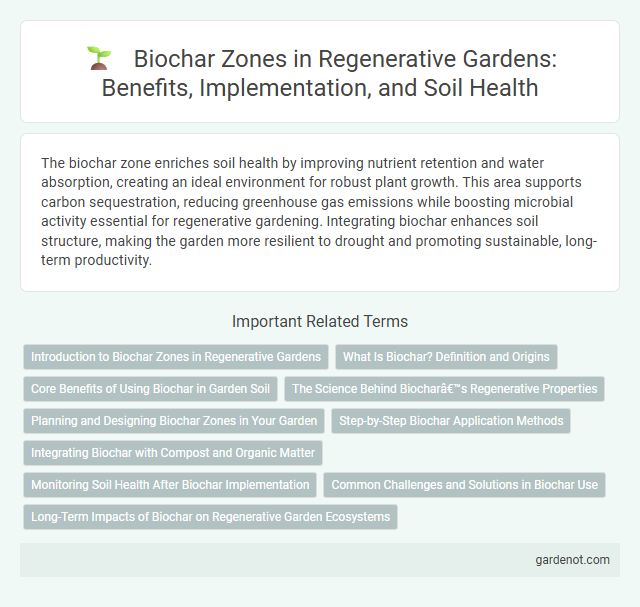The biochar zone enriches soil health by improving nutrient retention and water absorption, creating an ideal environment for robust plant growth. This area supports carbon sequestration, reducing greenhouse gas emissions while boosting microbial activity essential for regenerative gardening. Integrating biochar enhances soil structure, making the garden more resilient to drought and promoting sustainable, long-term productivity.
Introduction to Biochar Zones in Regenerative Gardens
Biochar zones in regenerative gardens enhance soil fertility by integrating charcoal-rich biochar, which improves water retention and microbial activity. These zones sequester carbon, reducing greenhouse gas emissions while promoting healthier plant growth and resilience. Implementing biochar zones supports sustainable agriculture through improved soil structure and nutrient cycling.
What Is Biochar? Definition and Origins
Biochar is a stable form of charcoal produced through the pyrolysis of organic materials like wood, crop residues, or manure in a low-oxygen environment. Originating from ancient soil management practices, biochar enhances soil fertility by improving water retention, nutrient availability, and microbial activity. This carbon-rich material plays a vital role in regenerative gardening by sequestering carbon and promoting sustainable soil health.
Core Benefits of Using Biochar in Garden Soil
Biochar significantly enhances soil fertility by improving nutrient retention and promoting beneficial microbial activity in garden soil. Its porous structure increases water retention, reducing irrigation needs and supporting plant resilience during drought. Incorporating biochar into garden soil also sequesters carbon, contributing to climate change mitigation while fostering sustainable garden ecosystems.
The Science Behind Biochar’s Regenerative Properties
Biochar enhances soil fertility by improving nutrient retention and promoting beneficial microbial activity through its porous structure. Its ability to sequester carbon plays a critical role in reducing greenhouse gas emissions and mitigating climate change. Studies demonstrate biochar's long-term stability in soil, contributing to sustainable agriculture and ecosystem restoration.
Planning and Designing Biochar Zones in Your Garden
Planning and designing biochar zones in your regenerative garden involves selecting well-drained, nutrient-poor soil areas to maximize biochar's soil-enhancing properties. Incorporate organic waste materials, such as plant residues and wood chips, into the biochar production process to create a sustainable nutrient cycle. Strategically position biochar zones near root systems to improve soil aeration, water retention, and microbial activity for healthier plant growth.
Step-by-Step Biochar Application Methods
Biochar application in a regenerative garden begins with selecting high-quality, sustainably sourced biomass such as wood chips or agricultural waste for pyrolysis. Once the biochar is cooled, it should be crushed to increase surface area and then mixed with compost or soil inoculants to enhance microbial activity before incorporation into garden beds. Applying biochar in a 5-10% soil volume ratio improves soil structure, water retention, and nutrient availability, promoting healthier plant growth and long-term soil regeneration.
Integrating Biochar with Compost and Organic Matter
Integrating biochar with compost and organic matter enhances soil fertility by improving nutrient retention and microbial activity. Biochar acts as a porous medium that absorbs and slowly releases nutrients, while compost adds essential organic compounds and beneficial microorganisms. This synergy increases soil carbon sequestration, boosts plant growth, and promotes a sustainable, regenerative garden ecosystem.
Monitoring Soil Health After Biochar Implementation
Monitoring soil health after biochar implementation involves regular testing of soil pH, nutrient levels, and microbial activity to assess improvements in fertility and structure. Biochar enhances soil carbon content and water retention capacity, promoting beneficial microbial communities and reducing nutrient leaching. Continuous observation of these parameters ensures the biochar zone supports regenerative growth and long-term soil vitality.
Common Challenges and Solutions in Biochar Use
Common challenges in biochar use within regenerative gardens include inconsistent nutrient release, potential contamination from feedstock, and difficulty in evenly integrating biochar into soil. Solutions involve selecting high-quality, contaminant-free feedstock, applying biochar with complementary organic amendments to balance nutrient availability, and utilizing proper mixing techniques to ensure uniform soil distribution. Monitoring soil pH and microbial activity helps optimize biochar benefits while mitigating adverse effects on plant growth.
Long-Term Impacts of Biochar on Regenerative Garden Ecosystems
Biochar enhances soil fertility by increasing nutrient retention and promoting beneficial microbial activity, leading to improved plant growth in regenerative gardens. Its stable carbon structure sequesters carbon for centuries, contributing to long-term climate change mitigation. Integration of biochar in garden ecosystems supports sustainable soil health and resilience, crucial for maintaining biodiversity and productivity over time.
Biochar zone Infographic

 gardenot.com
gardenot.com